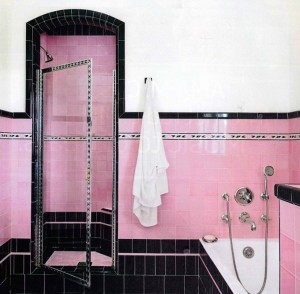From Gutted to Glam: Tile Makes 1930s Bathroom Remodel a Success
Bathroom tile from Mission Tile West was integral in creating the 1930s look.
 When designer Madeline Stuart was tasked with restoring the formerly glamorous 1930s Spanish Revival home of Broadway and Hollywood dancer Ann Miller, she didn’t have a lot to work with in the bathroom department. In fact, she had just one original item to guide her in restoring two large bathrooms back to period-appropriate style: a nickel-plated shower door frame decorated with a diamond pattern.
When designer Madeline Stuart was tasked with restoring the formerly glamorous 1930s Spanish Revival home of Broadway and Hollywood dancer Ann Miller, she didn’t have a lot to work with in the bathroom department. In fact, she had just one original item to guide her in restoring two large bathrooms back to period-appropriate style: a nickel-plated shower door frame decorated with a diamond pattern.
Using this one element as inspiration, Stuart and Mission Tile West worked together to create a stunning and unique design for each bathroom that incorporated classic elements of the 1930s aesthetic such as:
Bold Use of Color: Stuart chose bold tones she called “calamine pink” and “arsenic green” for the two bathrooms. Such vibrant colors would have been typical for the 1930s. The really important part was making sure that the large swaths of colored tile did not look flat and monotonous. Part of this was recreating the type of tile glaze that was used in the 1930s. This glaze maintains a significant amount of translucency, and each tile is slightly different. This gives the tile wall a watercolor effect which helps add subtle visual interest and keep the color from feeling monotonous.
Black Accents: Another very important way of making the bold colors work is adding black accents—lots of them. Stuart’s designs called for black accent tile liners literally outlining every edge of the tiled surfaces, from the edge where the floor meets the walls to the top edge of the shoulder-high tile walls to the edges of the built-in vanity mirrors and bathtub soap holders. Even the arched entry into the shower stall got specially made black tile to dress it up. All of this would have been common for a glamorous 1930s home.
Self-Rimming Tub: In the 1930s, bathtubs were designed to be “self-rimming,” meaning that you could tile all the way up to the edge. In this case, using a period-appropriate fixture was not only important for its own sake, but also for supporting the tile design in the whole bathroom and making it look truly authentic.
String Joint Grout: One final tile design touch that was absolutely necessary for creating the 1930s look was using a very narrow joint between the tiles. Rather than using modern spacers, installers literally used a piece of string to separate each bathroom tile as it was laid to create what was called string joint grout in the 1930s.
Are You Working on a Period Restoration Project?
If you need help sourcing authentic-looking tile for a period restoration project, Mission Tile West can help. Come browse our collection of vintage-inspired designs or chat with us about creating custom tile just for you.
